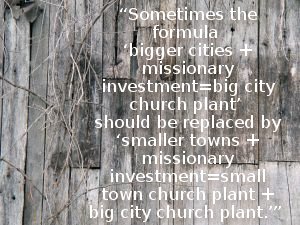Left Behind: The Apparent Absence of Fundamentalists in Resurgent Church Planting

While Fundamentalists often noisily do battle over issues important mostly to their sub-culture, there is a battlefield where Fundamentalists are conspicuous by their absence. There has been a resurgence in church planting in North America and few Fundamentalist churches have answered the call. The names of leaders in this resurgence are well-known and include Mark Driscoll, Tim Keller, Bob Roberts, and Ed Stetzer, to name a few. Whatever Fundamentalists think of these men, let there be no doubt that they are engaged in the most noble of tasks—the Great Commission—on a scale rarely seen and in cities which, with some notable exceptions, have been long abandoned by solid, Bible-believing churches. These leaders are not without their foibles, and controversy often surrounds or follows some of them. That said, it must be asked if there are any church planting movements in Fundamentalism with the depth and breadth of what is taking place in conservative evangelical circles.
Recently I attended a conference on church planting where several thousand active or prospective church planters and their wives were in attendance. Admittedly the presenters and attendees were from diverse evangelical backgrounds, a blessing in many ways in witnessing the diversity and unity of the body of Christ. Many in attendance could not plant churches together, a fact they recognized, due to doctrinal differences that are at the heart of one’s understanding of the nature the local church. One speaker, a prominent Southern Baptist leader, expressed his friendship with and admiration for Tim Keller, yet confessed that they could not plant a church together. There would be an immediate conflict over needing a bowl or a bathtub to baptize the first convert. Yet in spite of obvious differences and the inability to partner in church planting there was a laudable spirit of cooperation to help others plant churches by providing training, mentoring, and access to resources.
Discussion
God Came to "Kopano"

Kopano Baptist Church near Pretoria, South Africa, is about as unassuming an assembly as you will find anywhere on planet earth. Actually, you won’t find it at all unless an informed local leads you there. This fledgling church is tucked away off a rural road in a dusty village where neither fame nor fortune has ever dared show face. But God has.
According to church-growth gurus, Kopano Baptist Church is doing absolutely everything wrong. But unfazed by the dictates of such experts, God is working wonders in this obscure village through this humble church. Theirs is a story that will never be recorded on the glossy pages of prestigious journals or heralded in documentaries touting the latest ecclesiastical success story. Yet theirs is a story worthy of broadcast.
The village Kopano serves has no running water or sewer, no asphalt or gravel roads, no cars, sidewalks, street lamps or grass. Here the only things in noticeable abundance are stray dogs, brazen rats, cheap booze and abject poverty.
Kopano Baptist Church meets in an abandoned produce barn: no windows or interior walls, no carpet or restrooms, no banners, crosses, pictures, or decorative touches of any sort save the small hand-painted sign attached to the front wall that reads simply: “Kopano Baptist Church.” A few plastic chairs supplement the wooden crates that serve as pews. A string of four naked bulbs hangs over the center aisle—the electricity supplied via an extension cord plugged into the outlet of a nearby flat. Several candles waxed to the cement floor encircle the assembly to serve during the inevitable power outage. Parishioners share space with the rats—an improvement on an earlier day when rats shared space with the parishioners.
Discussion
The Gospel and Multiethnicity

Among those alive in 1989, who can forget the images of the fall of the Berlin Wall? It was one of those moments in life that make an indelible impression on many so that they remember where they were and what they were doing when it occurred. My family and I were living in France as the television broadcast live images of people scrambling over the wall and throngs of people standing on the wall singing while others with sledgehammers chipped away at the stark, ugly edifice which had separated the German people for decades. We recall President Reagan’s earlier words to Soviet leader Mikhail Gorbachev—“Mr. Gorbachev, tear down this wall!” A country that had been torn for decades was soon reunited.
That historic event may serve as a pale and imperfect analogy to what Christ accomplished at the cross when by His death, when through His blood, He brought peace to former enemies—Jews and Gentiles—by removing what the Apostle Paul in Ephesians 2:14 calls the “dividing wall of hostility,” and by “killing the hostility” (v. 16). Christ inaugurated a new state of being and a new way of living which is a model for believers today in our quest to experience and express the reality of being part of the new people of God.
Grace Church of Philadelphia is committed to “multi” in many ways—multi-generational, multi-socioeconomic and multi-ethnic ministry. Because we have a multi-ethnic missional objective, we want to be intentional in healing divisions and in celebrating God-given diversity. Our desire is that Grace Church reflect the diversity of our urban community and the diversity which exists in the body of Christ—not because it’s a great idea, although it is; not because we have overcome bigotry and eradicated all traces of prejudice from our hearts, because we haven’t; not because it will be easy, because it won’t be; but because there is a biblical basis for this commitment, because multi-ethnic diversity is God’s idea.
Discussion
Building a Biblical Model for House Churches
![]() The following is reprinted with permission from Paraklesis, a publication of Baptist Bible Seminary. The article first appeared in the Summer ‘08 issue.
The following is reprinted with permission from Paraklesis, a publication of Baptist Bible Seminary. The article first appeared in the Summer ‘08 issue.
The move from conventional congregations to house churches has been termed a revolution. Researcher George Barna estimates at least 1 million Americans have shifted to small-groups worshiping primarily in homes or businesses.
But the revolution comes in this statistic: by 2025, Barna predicts 70 percent of Christians will be worshiping in such “alternative faith communities.”1
While the trend is clear, the benefits and biblical focus of such gatherings is more muddled. The early church detailed in the New Testament indeed met “house to house,” and the Apostle Paul regularly gathered new believers in homes. But this is not an exclusive or biblically prescribed model for worshiping.
The home church model can work today, and in circumstances where proper ty is scarce or expensive it can be a practical approach. Pastors and church leaders, though, need to think clearly before moving to a house church model. They must keep a biblical focus paramount and not let relational benefits overrun sound doctrine and New Testament church polity.
Inside house churches
House churches are small bodies of believers that meet primarily in homes, have generally fewer than 30 members, and normally have unpaid lay leaders. These back-to-basics congregations do not start in a home with the goal of moving later to a permanent facility. They are designed to stay in a private residence or similar surroundings.
Discussion
From Hillbilly to City Slicker, or The "Li'l Abner" Approach to Urban Missions
 Few people have ever captured and caricatured all levels of American society more successfully than did cartoonist Al Capp in his classic comic strip “Li’l Abner.” Arguably, the funniest sequences in the series are those where Abner, Mammy, or other members of the Yokum clan venture from their home in Dogpatch into the big city. There they interact with the urbanites, and hilarity ensues. For all of their sophistication and culture, the socialites can never seem to get the best of the hillbillies from the Ozarks.
Few people have ever captured and caricatured all levels of American society more successfully than did cartoonist Al Capp in his classic comic strip “Li’l Abner.” Arguably, the funniest sequences in the series are those where Abner, Mammy, or other members of the Yokum clan venture from their home in Dogpatch into the big city. There they interact with the urbanites, and hilarity ensues. For all of their sophistication and culture, the socialites can never seem to get the best of the hillbillies from the Ozarks.
The purpose of this article is to suggest that Al Capp—unwittingly, to be sure—suggests a viable model for rural/urban church planting.
In today’s evangelical world there is a heartening new emphasis on the church plant. Many of the efforts are being focused on urban centers—with works like Redeemer Presbyterian in New York or Mars Hill in Seattle being held up as examples for others to follow. Cities are the natural choice, it is argued, because they have more people, and because they set the culture for the rest of the world.
Based on those two facts, I heard one preacher affirm that all ministries (and the context was “church-planting”) should be city-focused.
While the above mentioned factors cannot be denied, I would like to suggest that they do not tell the whole story. Let me share two observations gleaned from my formative years in the US and our current ministry in Northeast Brazil.
Discussion
Planting Urban Churches, Part 2
 Read Part 1.
Read Part 1.
Cultural accommodation is a genuine danger in planting churches. However, a real problem is the one-sided perspective that many have of accommodation. Usually the accommodation is seen rightly (Rom. 12:2) but narrowly only toward the world, caving in to worldly culture in dress, music, and questionable practices and associations. Frequently forgotten is the cultural accommodation toward Christians, generally well-meaning but misguided, who have a truncated view of the Christian life and seek to impose discipleship as they’ve known and experienced it as normative for all believers. Thus, there are twin dangers of cultural accommodation: 1) Accommodating or catering to the unchurched in designing worship from a seeker-driven mentality; 2) Accommodating or catering to the churched who come to the new church plant with their preferences paraded mistakenly for biblical convictions.
A recent article on urban church planting elicited mixed responses for which I’m mostly glad. I appreciate it when others point out weaknesses or would like more clarification. Since I’m not a blogger I don’t have a cadre of lapdogs to pat me on the back and cheer me on as seems to be the case with select blogs. A few people, in reading between the lines, may have understood my encouraging the removal of barriers to the gospel in thinking that doing so would allow people to more easily accept the gospel message. I’m all for getting rid of unnecessary barriers which prevent people from hearing the gospel. But there was no suggestion that getting rid of pews, ties, and changing the music will bring more people to Christ.
Nonetheless, I must maintain that I have no problem with an established church which desires biblical transformation or new churches started with a different model. Pew or chairs; Sunday best , business casual or jeans; morning and evening service or morning only; small groups or Wednesday evening prayer meeting—you may find biblical allowance, but you will not find biblical warrant for all your choices. What slightly amazes me is that many seem to care so much about churches where they have no voice of influence, only criticism.
Discussion
An Epistle on Church Planting
 Demetrius, a fellow worker for the truth, to Georgias, whom I love in truth.
Demetrius, a fellow worker for the truth, to Georgias, whom I love in truth.
Grace and peace from God the Father and Jesus Christ his Son.
It is my greatest desire that you walk in the truth that our brother John received from Jesus Christ, handed on to me, and which I am now handing on to you. My time of labor is almost over, but I commit this to you now so that you may be able to teach others also.
In order to abide in the tradition, you must understand that God is light; therefore, those who have fellowship with him must walk in the light. In order to live the tradition, you must understand that God is love; therefore, those who know him must walk in love. These underlying principles are true throughout all of creation, and they form a basic presupposition for everything I say to you: God’s nature must control how we live if we are to achieve the purpose for which we were created and redeemed. To say this in another way, everything God created has a nature and a purpose, and it must operate according to that God-given nature and purpose if it is to thrive. This is also true of the church you are seeking to plant. You must know what the church is, what the church is for, and what obligations that creates for you.
Discussion
Planting Urban Churches


Discussion